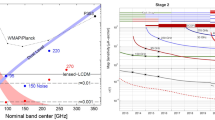Abstract
The BICEP/Keck (BK) experiment aims to detect the imprint of primordial gravitational waves in the cosmic microwave background polarization, which would be direct evidence of the inflation theory. While the tensor-to-scalar ratio has been constrained to be \(r_{0.05}<0.06\) at 95% c.l., further improvements on this upper limit are hindered by polarized galactic foreground emissions and removal of gravitational lensing polarization. The 30/40 GHz receiver of the BICEP Array (BA) will deploy at the end of 2019 and will constrain the synchrotron foreground with unprecedented accuracy within the BK sky patch. We will show the design of the 30/40 GHz detectors and test results summarizing its performance. The low optical and atmospheric loading at these frequencies requires our TES detectors to have low saturation power in order to be photon noise dominated. To realize the low thermal conductivity required from a 250 mK base temperature, we developed new bolometer leg designs. We will present the relevant measured detector parameters: G, \(T_c\), \(R_n\), \(P_\mathrm{sat}\), and spectral bands, and noise spectra. We achieved a per bolometer NEP including all noise components of \(2.07\times 10^{-17}\,\mathrm{W}/\sqrt{\hbox{Hz}}\), including an anticipated photon noise level \(1.54\times 10^{-17}\,\mathrm{W}/\sqrt{\hbox{Hz}}\).







Similar content being viewed by others
References
Bicep/Keck Collaboration, Phys. Rev. Lett. 121, 22 (2018). https://doi.org/10.1103/PhysRevLett.121.221301
H. Hui, et al., Proc. SPIE 10708, id. 1070807, (2018), https://doi.org/10.1117/12.2311725
M. Crumrine, et al., Proc. SPIE 10708, id. 107082D, (2018), https://doi.org/10.1117/12.2312829
BICEP2 and Keck Array Collaboration, SPIDER Collaboration ApJ 812, 176 (2015). https://doi.org/10.1088/0004-637X/812/2/176
A. Schillaci, et al., J. Low Temp. Phys. (2020). https://doi.org/10.1007/s10909-020-02394-6
A. Soliman, et al., J. Low Temp. Phys. (2020). https://doi.org/10.1007/s10909-019-02299-z
Acknowledgements
The BICEP/Keck project have been made possible through a series of grants from the National Science Foundation including 0742818, 0742592, 1044978, 1110087, 1145172, 1145143, 1145248, 1639040, 1638957, 1638978, 1638970, and 1726917 and by the Keck Foundation. The development of antenna-coupled detector technology was supported by the JPL Research and Technology Development Fund and NASA Grants 06-ARPA206-0040, 10-SAT10-0017, 12-SAT12-0031, 14-SAT14-0009 and 16-SAT16-0002. The development and testing of focal planes were supported by the Gordon and Betty Moore Foundation at Caltech. Readout electronics were supported by a Canada Foundation for Innovation grant to UBC. The computations in this paper were run on the Odyssey cluster supported by the FAS Science Division Research Computing Group at Harvard University. The analysis effort at Stanford and SLAC is partially supported by the U.S. DoE Office of Science. We thank the staff of the U.S. Antarctic Program and in particular the South Pole Station without whose help this research would not have been possible. Tireless administrative support was provided by Kathy Deniston, Sheri Stoll, Irene Coyle, Donna Hernandez, and Dana Volponi.
Author information
Authors and Affiliations
Corresponding author
Additional information
Publisher's Note
Springer Nature remains neutral with regard to jurisdictional claims in published maps and institutional affiliations.
Rights and permissions
About this article
Cite this article
Zhang, C., Ade, P.A.R., Ahmed, Z. et al. Characterizing the Sensitivity of 40 GHz TES Bolometers for BICEP Array. J Low Temp Phys 199, 968–975 (2020). https://doi.org/10.1007/s10909-020-02411-8
Received:
Accepted:
Published:
Issue Date:
DOI: https://doi.org/10.1007/s10909-020-02411-8




